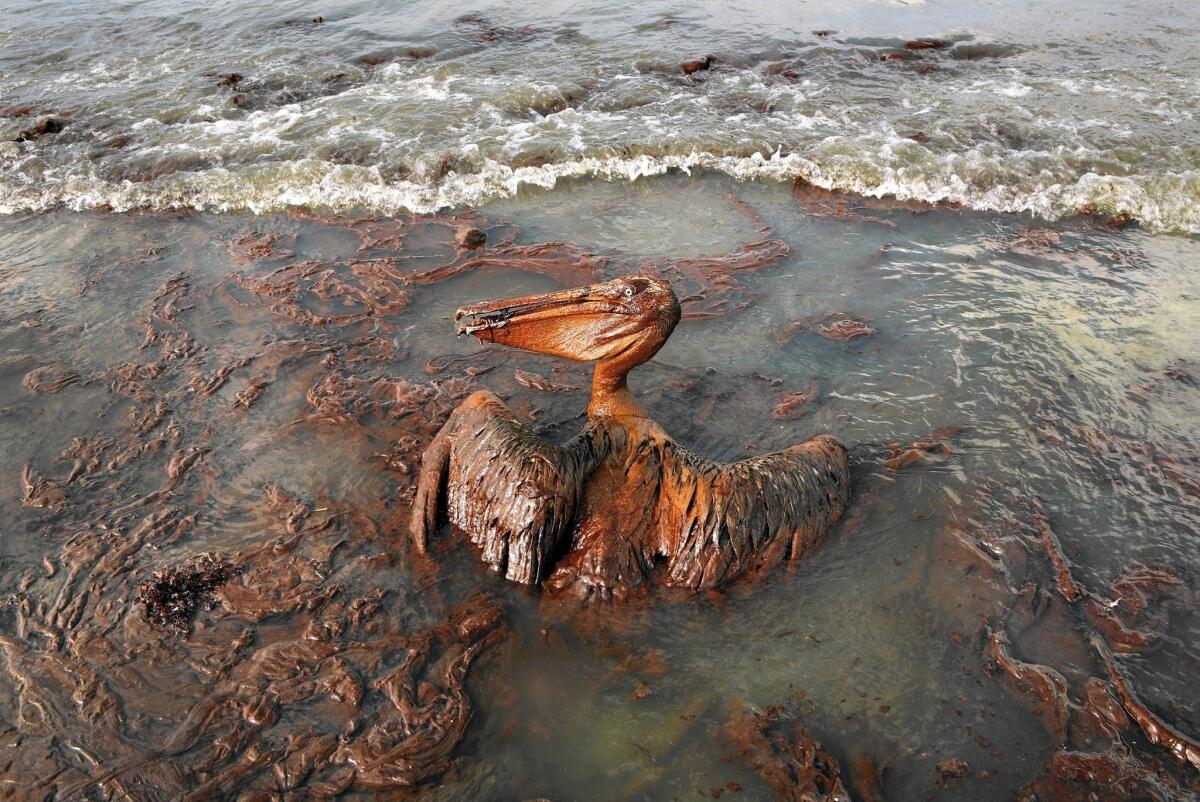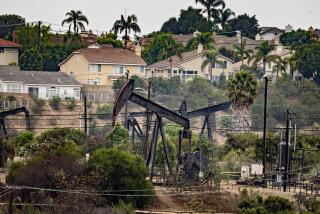Five years after BP spill, new rules for offshore drilling aim to boost safety

Weeks after the
There aren’t many issues on which government regulators, oil industry experts and environmentalists can all agree, but five years after the BP gulf oil spill, many say offshore drilling operations are safer — although there is debate over whether ocean drilling should be expanded.
On April 20, 2010, the Deepwater Horizon oil rig exploded in the Gulf of Mexico, killing 11 people in one of the nation’s worst environmental disasters. For 87 days, the country was transfixed by images of millions of barrels of oil gushing from the seafloor, coating marine life and soiling more than a thousand miles of coast from Texas to Florida.
The spill of 3.19 million barrels of oil into the gulf, an amount determined by a federal judge, upended how the federal government regulates offshore drilling. The Obama administration has proposed a series of regulations to prevent a repeat of the disaster, or at least to mitigate the worst of the effects. Some of the changes are based on improved technology to better seal well ruptures. Others involve added safety tests by more inspectors.
The proposed rules, which will be open for two months of public comment, come at a crucial time. Offshore drilling accounts for about 16% of the nation’s oil and 5% of its natural gas, and will probably grow. The administration for the first time has proposed opening up areas along the southeastern U.S. coast to drilling. The Interior Department also is grappling with an application by Royal Dutch Shell to begin exploratory drilling in the Chukchi Sea off the coast of Alaska, where the Arctic poses even more challenges than the Gulf of Mexico.
“A lot has occurred to make offshore drilling safer,” Brian Salerno, director of the federal Bureau of Safety and Environmental Enforcement, said in an email. He cited the proposed rules and improved technology to contain spills. “All of this serves to reduce risk, and they are positive steps.”
The industry is generally content with the new rules, but environmentalists would rather not have offshore drilling operations spread.
“Yes there have been improvements that Obama and others have put in place, but we still see spills,” said Raleigh Hoke, communications director for the environmental group the Gulf Restoration Network. “For those living in Alaska and want to see what lies ahead, take a serious look at what is happening in the gulf.”
The disaster
Late on April 20, the Deepwater Horizon was drilling for BP about 40 miles off the coast of Louisiana. About 5,000 feet below the surface, a bubble of methane is believed to have burst free of the well and expanded through the drill column. Witnesses told investigators later that the lights flickered and there were two strong shakes as the blowout began and the fire raged. After burning longer than a day, the rig sank on April 22.
The disaster touched off legal battles about liability that are ongoing. U.S. District Judge Carl Barbier ruled that BP acted with “gross negligence and willful misconduct.” The oil company reached a $4.5-billion criminal settlement with the Justice Department in 2012 and paid $14 billion for cleanup.
According to a study prepared by the Natural Resources Defense Council, more than $11.6 billion has been paid to individuals. Commercial fisherman could lose $8.7 billion by 2020 along with 22,000 jobs, and lost tourism dollars are more than $22.7 billion.
More government regulation
Before the disaster, the Minerals Management Service, part of the Department of the Interior, was the one-stop federal agency handling all issues related to natural gas and oil production on the continental shelf. It awarded leases, collected royalties, conducted environmental impact studies and carried out safety inspections — prompting complaints that its mission created conflicts of interest. For example, how could the same agency seeking to increase oil revenue be trusted to strictly regulate safety, which could cut income?
A month after the disaster, Interior Secretary Ken Salazar ordered that the agency be split into the Bureau of Ocean Energy Management, the Bureau of Safety and Environmental Enforcement and the Office of Natural Resources Revenue. Each arm focused on a different task, separating revenue from safety and both from leasing issues.
Separation is good for all of the agencies, said Eileen P. Angelico, a spokeswoman for the Bureau of Safety and Environmental Enforcement. “I think it allows us to focus on our mission and to do it more effectively than before.”
The new regulations
The latest rules are the third round since the disaster was investigated by several agencies. There were a variety of errors that contributed to the explosion, but investigators cited the failure of the blowout preventer, which should have been the last line of defense. The preventer is a five-story collection of valves and blades, including an emergency hydraulic device with two sharp cutting blades called a blind shear ram. The blades are designed to cut and seal the drill pipe, stopping a blowout.
According to the Chemical Safety Board, the drill pipe buckled, preventing the blades from working cleanly. The new requirements call for double shear rams “with an enhanced capability to shear pipes.” Doubling the blades can mean quicker cuts as well as a backup if the first set fails.
In addition to the tougher rules, regulators cite the increase in the number of inspectors, from 55 to 92, as part of the safety push. The agency also wants any company doing deep-water drilling to have access to better containment domes. Two such prevention domes are on station in the gulf.
The new government regulations reflect the technological advances and heightened standards already in effect, according to the oil industry’s Center for Offshore Safety. “America’s offshore oil and natural gas industry is even safer than before, but our goal will always be zero accidents and zero spills,” said Charlie Williams, the group’s executive director.
“These rules build on the lessons learned from the disaster and that’s a good thing because it requires everybody to operate at the highest industry standard,” said Bob Deans, a spokesman for the Natural Resources Defense Council. “It’s a step in the right direction, but the blowout preventer is like life insurance: It is good to have, but you never want to need to use it. When you do need it, you want it to work.”
But, he cautioned, all machinery is built by people and “humans can err. You can’t ever make it completely fool-proof,” an argument he and other environmentalists use in their calls against expanding offshore drilling.
The environment
The full effects in the Gulf of Mexico may not be known for years, environmentalists say.
“I remain quite concerned about the impact on the whole ecosystem itself and what it will take to have it back and truly healthy,” said Patrick Rose, executive director and aquatic biologist at the Florida-based Save the Manatee Club. “There will be long-lasting effects from the oil. There will be long-lasting effects from the dispersants. We may not be seeing oil sheens on the water, but there is a good way to go before the gulf gets back to where it needs to be.”
As many as 5,000 marine mammals may have been killed along with 1,000 sea turtles and nearly 1 million coastal and offshore seabirds, the environmental group said.
Others, however, are more sanguine. The Harte Research Institute for Gulf of Mexico Studies at Texas A&M University-Corpus Christi is one of a string of universities receiving funds to study the oil spill effects, and its executive director, Larry McKinney, compared the gulf to a rubber band that is snapping back. Crabs, shrimp and oysters have shown no lasting effects from the spill, McKinney said. But he warned that more studies were needed.
“The spill was a tremendous test of that resiliency, and five years later it seems the gulf has passed,” McKinney said. “But questions remain about the impact of the spill on long-lived species like turtles, marine mammals, cold-water corals and the deep gulf ecosystem. If you continue to stretch a rubber band to its limit, you’re losing some of that elasticity and making it weaker. That is the concern we must have for the gulf.”
More to Read
Sign up for Essential California
The most important California stories and recommendations in your inbox every morning.
You may occasionally receive promotional content from the Los Angeles Times.











